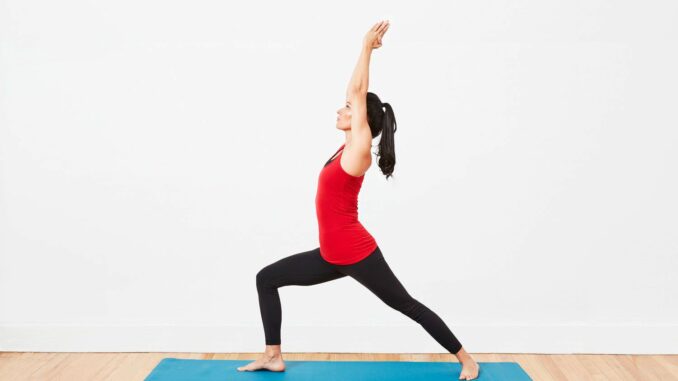
Creating a basic yoga routine is a wonderful way to integrate mindfulness, flexibility, and strength into your daily life. Yoga offers numerous physical and mental benefits, including improved posture, reduced stress levels, increased flexibility, and enhanced overall well-being. This comprehensive guide will help you establish a simple yet effective yoga routine that you can practice regularly:
Benefits of Yoga
Before diving into the routine, it’s essential to understand the benefits of practicing yoga:
- Physical Benefits:
- Improves flexibility, balance, and strength.
- Enhances posture and body awareness.
- Promotes better circulation and cardiovascular health.
- Helps in managing weight and toning muscles.
- Mental Benefits:
- Reduces stress, anxiety, and depression.
- Improves focus, concentration, and mental clarity.
- Enhances relaxation and promotes better sleep.
- Boosts overall mental well-being and mindfulness.
Preparing for Your Yoga Practice
- Choose a Comfortable Space:
- Find a quiet and spacious area where you can practice without distractions.
- Use a yoga mat or a non-slip surface to ensure stability during poses.
- Wear Comfortable Clothing:
- Opt for breathable and stretchable attire that allows for unrestricted movement.
- Remove shoes and socks to maintain stability and connection with the ground.
- Gather Your Props (Optional):
- Have yoga blocks, straps, or bolsters nearby to assist in achieving proper alignment and deeper stretches.
Basic Yoga Routine
1. Start with Centering (1-2 minutes)
- Sit comfortably on your mat with crossed legs or in a kneeling position.
- Close your eyes and take a few deep breaths to center yourself.
- Bring awareness to your body and set an intention for your practice (e.g., calmness, strength, or flexibility).
2. Warm-Up (5-10 minutes)
- Begin with gentle movements to warm up your body and prepare for deeper stretches.
- Perform gentle neck rolls, shoulder shrugs, and wrist circles.
- Incorporate dynamic movements like Cat-Cow stretches or gentle spinal twists.
3. Standing Poses (10-15 minutes)
- Move into standing poses to build strength, balance, and flexibility.
- Start with Mountain Pose (Tadasana) to align your body and focus on steady breathing.
- Progress to poses like Warrior I (Virabhadrasana I), Warrior II (Virabhadrasana II), and Triangle Pose (Trikonasana).
- Hold each pose for 5-8 breaths, focusing on grounding through your feet and maintaining proper alignment.
4. Seated Poses (5-10 minutes)
- Transition to seated poses to increase flexibility and release tension.
- Practice Seated Forward Fold (Paschimottanasana) to stretch the hamstrings and lower back.
- Follow with Butterfly Pose (Baddha Konasana) to open the hips and groin area.
- Incorporate gentle twists like Seated Spinal Twist (Ardha Matsyendrasana) to improve spinal mobility.
5. Cooling Down (5 minutes)
- Conclude your practice with calming and cooling poses to relax the body and mind.
- Perform Corpse Pose (Savasana) by lying flat on your back with arms at your sides, palms facing up.
- Close your eyes and focus on your breath, allowing your body to fully relax and integrate the benefits of your practice.
6. Final Meditation and Relaxation (3-5 minutes)
- Sit or lie down comfortably for a brief meditation or relaxation session.
- Focus on deep breathing and observe any sensations or thoughts that arise without judgment.
- Visualize yourself feeling calm, balanced, and rejuvenated.
7. Closing Your Practice
- Slowly transition back to a seated position and bring your hands together at your heart center.
- Take a moment to express gratitude for your practice and its benefits.
- Bow your head as a gesture of respect and completion.
Tips for a Successful Yoga Practice
- Listen to Your Body: Honor your body’s limitations and avoid pushing yourself into discomfort.
- Breathe Mindfully: Focus on deep, even breaths throughout your practice to enhance relaxation and maintain focus.
- Consistency: Establish a regular yoga routine, even if it’s just a few minutes each day, to experience the cumulative benefits over time.
- Modify as Needed: Use props or modify poses to accommodate any injuries or physical limitations.
- Seek Guidance: Consider attending yoga classes or workshops to learn proper techniques and alignment from certified instructors.
Conclusion
A basic yoga routine offers a holistic approach to physical and mental well-being, promoting flexibility, strength, relaxation, and mindfulness. By incorporating the steps outlined in this guide into your daily or weekly routine, you can cultivate a healthier and more balanced lifestyle through the practice of yoga.
Whether you’re a beginner or experienced practitioner, adapting this simple routine to suit your needs and preferences will help you reap the numerous benefits of yoga. Enjoy your journey towards improved health and inner harmony!